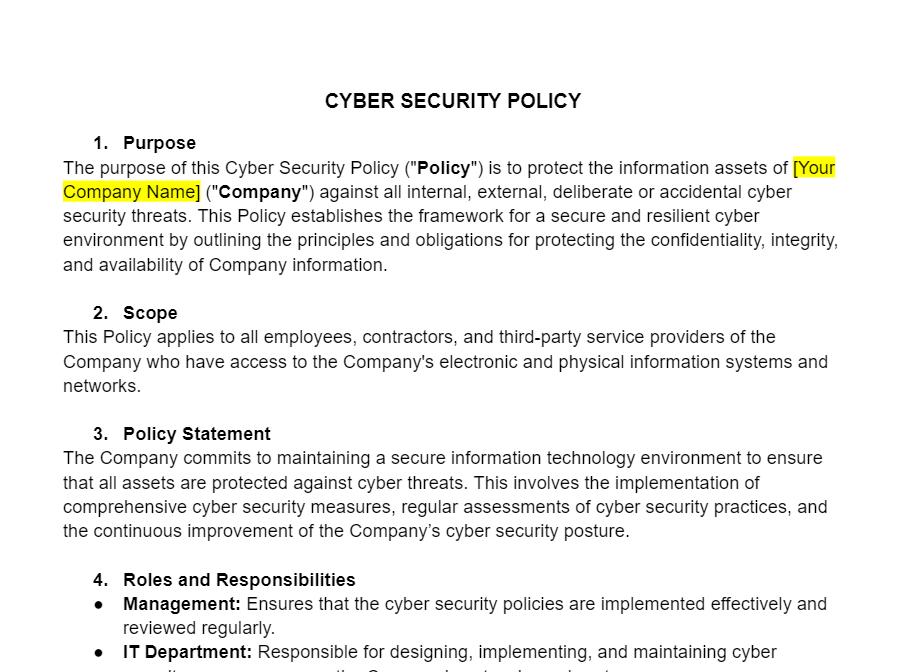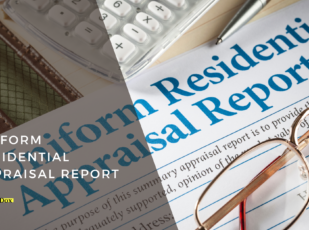
Cybersecurity Policy Template
18 Downloads
IT and Media
January 11, 2025
Sayantani Dutta
Imagine a set of rules that defines how your information systems are accessed, used, and protected; that would be your cyber security policy template. This policy template is not solely for the IT department to utilize but an overall framework everyone in the organization should know and follow.
It defines what employees can and cannot do with the company’s data, and how personal information should be handled, and it clearly outlines the course of action in case of a data breach. Beyond that, it means your organization is not just responding to cyberattacks but rather readying for such eventualities.
For example, it might specify that employees use multi-factor authentication protocols, limit employee access to private networks, or define rules for the secure use of wi-fi in remote work environments.
The Many Faces of a Cyber Security Policy
Think of your information security policy as a multilayered strategy, designed to address the complexities of modern information technology, with every aspect reinforcing the others. A well-written policy can never be a one-size-fits-all solution.
A small tech startup is going to approach data security very differently from a large financial institution. But despite such differences, there are elements that are common to all.
Acceptable Use Policies (AUP)
These dictate the use of company systems. What sites can employees visit? What can they download? Clarity preempts abuse.
Access Control
This policy denotes who has permission to the sensitive parts of the system. Every employee doesn’t have to have access to the “digital vault.”
Incident Response Plans
Whether it’s dealing with a phishing scam, malware attack, or any security incident, this plan serves as your step-by-step guide. Consider this your fire drill in the case of a data breach.
Remote Work Guidelines
With remote work now the norm, ensuring secure connections to private networks, especially over public wi-fi, is critical.
Disaster Recovery Plans
While an incident response plan is about immediate reaction, the disaster recovery plan deals with how to return to business: how you’ll restore the systems and data, and how long it takes to do so.
Creating a Cyber Security Policy That Works
Start with identifying particular risks of your organization. Does it deal with sensitive information in bulk? Do employees remotely access the database through insecure connections?
Once you have identified your vulnerabilities, the next step is writing the policy, ensuring that potential security breaches are addressed on a case-by-case basis. Skip the vague platitudes; instead, detail technical safeguards like encryption standards, firewalls, and endpoint monitoring. Instead of saying, “Keep data secure,” explain how.
Implementation is as important as design. A well-written policy means absolutely nothing if it’s not followed. Train employees to build security awareness, implement and test security controls, and communicate expectations clearly. Regular updates mean the policy will evolve to meet emerging threats.
Why This Document Isn’t Optional
Every sensitive piece of information, each access point in your private networks, and each login to company systems represents a potential vulnerability. Without having a policy that clearly guides the use of these systems, those vulnerabilities present an infosec threat.
A thoughtful, well-executed policy doesn’t just make your business safer; it gives you a roadmap through the complexities of modern cyber threats. It means you’re not just reacting to risks but managing them proactively.
This is not a document to be filed and forgotten. A cybersecurity policy is dynamic, a living set of principles and rules that adapt to the shifting dynamics in the ever-changing nature of digital threats.
The establishment of a comprehensive cyber security policy is a multi-dimensional process that involves careful consideration of risks, goals, technologies, and existing practices. The following steps provide a clear pathway for the creation of a complete infosec policy.
Step 1: Conduct Thorough Risk Assessment
Every good cybersecurity policy finds its origin in a proper risk assessment. This means the analysis of your organization’s vulnerabilities, assets, and the threat landscape in which it operates to identify risks and prioritize resolving those you find.
Evaluate Security Risks
Continuously monitor your organization’s internal and external cyber-threat landscape. Consider adopting one of the following representative established frameworks.
- NIST Cyber Security Framework
- ISO/IEC 27005:2018: Aims at resolving risk management issues through the standards outlined in ISO 27000.
- FAIR: Factor Analysis of Information Risk. It translates the risk into quantitative financial terms to improve financial decision-making.
Identify Critical Assets
Inventory all information assets that need protection, including hardware, software, mobile devices, information systems, and sensitive data. Classify data by its business impact to prioritize resources correspondingly.
Map Asset Locations
Create a detailed mapping of asset locations, including physical placement and integration into the network. Document access levels and existing protections to identify vulnerabilities in private networks.
Understand the Threat Landscape
Keep up with the latest cyber threats and trends that could impact your business. Make the analysis relevant to your organization’s specific risks. Keep yourself updated on wi-fi vulnerabilities and mobile access threats, which are common in work-from-home environments.
Prioritize Risks
Prioritize the identified risks based on the likelihood and potential impact. Resource allocation should be done accordingly, giving priority to the most critical vulnerabilities.
Reduce the Attack Surface
Reduce the number of potential entry points for cyber attackers by implementing network security measures, proper configuration of firewalls, and endpoint protection. Limit access to necessary applications and private networks.
Step 2: Define Your Security Goals
With a clear understanding of your risks, the next step will be to set specific and measurable security objectives. These goals reflect your organization’s risk tolerance and security maturity.
Establish Security Objectives
Examples of effective goals include:
- Enhancing network defenses
- Improving protection for sensitive data
- Improvement of the response times to incidents
- Meeting the Industry’s compliance standards
Set Realistic Expectations
Align priorities with the resources and capabilities of the organization. Utilize the risk assessment to assist in setting these priorities in such a manner that they can be realistically formed and realized.
Step 3: Assess Your Technology Infrastructure
You have to understand what your current technology stack can and can’t do in order to build a solid cyber security policy.
Inventory Existing Technology
Document all hardware and software, including mobile devices and remote access tools. Provide an assessment regarding whether the security features are current: identify systems not meeting current security standards and requirements.
Evaluate Resource Availability
Make sure your organization has the people, training, and budget to properly care for and secure these technologies.
Address Redundancies
Identify redundant tools or systems with duplicate functionalities adding to the complexity while increasing costs. Consolidate where possible to reduce operations and security gaps.
Map Data Flows
Understand the flow of personal data and other critical information in your systems, including the mobile and wi-fi access points. Look out for points of vulnerability in the handling, processing, storage, or transfer of data to enhance the security of data.
Step 4: Review Current Security Policies
The best cybersecurity policy is built on the backbone of existing practices. A full review will help ensure that modern threats and technologies are aligned.
Audit Current Policies
Compile and review all existing policies. Compare them for compliance with industry standards. Ensure policies address such areas as the use of mobile devices, wi-fi security, and private network access.
Evaluate Enforcement
Determine if policies are actively enforced. Investigate instances of non-compliance and ensure procedures are in place for issuing disciplinary action when necessary.
Provide a Disclaimer
Also, include a disclaimer in your policies to show limitations and clearly explain organizational accountability. This helps different employees to understand their role in maintaining security and protecting sensitive data.
Step 5: Develop a Risk Management Plan
The development of risk management in as much detail as possible is important for enhancing the cyber security defenses of your organization. The plan should be a living, actionable framework that directly addresses the risks identified through the risk assessment of Step 1 and supports the accomplishment of the security goals established in Step 2.
Here’s how to develop an appropriate risk management plan.
Consolidate Risk Assessment Findings
Start by compiling all data from your risk assessment, including possible vulnerabilities in private networks, wi-fi systems, and sensitive data handling. Update risk profiles for the latest threat intelligence and business changes.
Risk Management Objectives
Your goals should be as close to your organization’s security objectives as possible and be measurable and attainable.
- Reduce the vulnerabilities associated with mobile devices.
- Enhancing the detection of unauthorized access to private networks.
- Improve employee training to reduce the likelihood of internal risks.
Develop Risk Mitigation Strategies
Prioritize the risks according to their potential impact and likelihood of occurrence. Consider mitigation techniques for each, which may include deploying stronger encryption or restricting access to critical systems.
Implement Risk Controls
Apply various controls, both technical and administrative.
- Fortify network defenses with updated firewalls and endpoint security.
- Revise and enforce policies affecting areas of vulnerability, such as wi-fi security and management of mobile devices.
- Educate employees on security best practices, ensuring they understand the consequences relative to non-compliance, including disciplinary action.
Establish Monitoring and Review Processes
Establish processes for ongoing risk monitoring and reviewing control effectiveness. These feedback mechanisms ensure that employees can report issues anonymously.
Incident Response and Recovery Plan
Develop or improve an incident response plan.
- Steps to contain and address breaches.
- Business continuity measures to reduce downtime.
- Data recovery protocols to secure sensitive data and restore normal operations.
Document and Communicate the Plan
Document everything regarding the risk management plan, including a disclaimer to state the scope and limitations of the document. The document should be made available to all relevant stakeholders and communicated throughout the organization.
Review and Update on Regular Basis
Periodically re-evaluate the plan to ensure it remains relevant to the current threat environment and grows with the growth of the organization and technology advancements.
Step 6: Password Requirements
Passwords are critical layers of defense in your organizational cybersecurity strategy. To prevent unauthorized access to systems and sensitive data, develop strict password policies that can act as a barricade to bad actors.
Enforce Strong Password Policies
Impose the use of complex passwords that include a mix of uppercase, and lowercase letters, numerals, and special characters. Change passwords periodically to minimize the window of vulnerability.
Implement Password Managers
Encourage or force your employees to utilize password managers such as LastPass for creating and storing strong, unique passwords in each system.
Integrate Multi-Factor Authentication (MFA)
Always enable MFA wherever possible, most especially in all cloud-based systems and tools. It adds security so that if one password gets compromised, unauthorized entry is still not possible.
Step 7: Set Rules for Technology Use
The way employees interact with company technology directly impacts your organization’s overall security posture. To create a controlled digital environment, institute clear rules and well-defined guidelines.
Define Acceptable Usage Policies
Develop comprehensive policies on acceptable and unacceptable uses of company technology. Include downloading software, installing applications, and handling mobile devices.
Secure Company Devices
Implement security for all devices in the following manner.
- Installation of antivirus software and firewalls.
- Regularly enforce security updates.
- Limiting administrative access and privileges will prevent the installation of unauthorized software.
Educate Employees
Train employees on how to use their devices properly: provide tips for avoiding phishing attacks, using wi-fi safely, and following the security rules. Explain policy violations and the consequences, which include disciplinary action.
Monitor and Audit Device Usage
Monitor the use of company devices by employees from time to time and take necessary action against the policies based on individual merits. Use monitoring tools to identify misuse.
Step 8: Establish Standards for Social Media and Internet Use
How your organization interacts with the internet and social media platforms is very important to the organization’s posture on cyber security. Implement a clearly defined Internet Usage Policy that defines acceptable online behavior and outlines what types of activities and sites are inappropriate or high-risk.
Developing Internet Usage Policies
Create a comprehensive policy that outlines safe and acceptable internet use.
- Websites and practices that are regarded as unsafe and inappropriate, such as loading unverified programs or accessing sites that are labeled high-risk.
- Specific guidelines on how to safeguard sensitive information while browsing or over public wi-fi.
Social Media Usage Policy
Social media places a number of unique demands on cybersecurity, particularly when the line separating personal use from professional applications is thin.
- Specify how employees can represent the company or discuss work-related matters online.
- Address the possible risks of sharing sensitive data on social platforms.
- Emphasize the importance of following strategies for communication approved by the company as ways to avoid cyber threats and reputational damage.
Incorporating ISO 27001 Standards
The ISO 27001 Information Security Standard provides a globally recognized framework for information security management. This sets a standard whereby your policies will show how your organization is committed to securing its private networks and data and promoting best practices.
Step 9: Strengthen Email Security
E-mail systems are favorite targets of cybercriminals, and phishing is one of the most widespread kinds of attacks.
Educating Employees
- Recognize phishing attempts and avoid clicking on suspicious links.
- Recognize the risk of downloading attachments from unknown senders.
- Encrypt the confidential emails for safety.
Establishing Clear Email Policies
Define rules for using email securely.
- Try not to forward company-related emails to your personal accounts.
- Transmit sensitive information using secure means. Report suspicious emails to the IT or security team.
With these measures in place, your organization can minimize the chances of email-based attacks and further secure its overall security posture.
Step 10: Implement the Cyber Security Policy
Once your cyber security policy is developed, the next step is implementation. Implementation means taking the strategies and integrating them into your organization’s operations and culture.
Management should actively advocate for cyber security and model best practices. Their commitment is critical to building a culture of vigilance.
Communicate the Policy
The cybersecurity policy needs to be communicated to all employees, explaining how it will help in protecting the organization. Let every team member understand their role and responsibilities. Regular training should cover the following.
- Cover the key aspects of the cyber security policy.
- Include mobile device and wi-fi security guidelines.
- Address the consequences of non-compliance, such as disciplinary action.
Integrate Security into Daily Operations
Embed security measures into workflows, enabling the use of security enforcement tools such as firewalls, secure email gateways, and intrusion detection systems.
Maintenance and Upgrade of Systems
Keep all software, systems, and policies updated. Regular maintenance will help to mitigate emerging vulnerabilities and threats.
Step 11: Prepare for Incidents with Test Runs
Preparation for cyber incidents is not optional. Test your response plan to ensure it’s effective if a real incident happens. Develop an incident response plan consisting of the following.
- An incident response team whose roles are well outlined.
- Communications protocol for internal and external stakeholders.
- Prioritization of key assets and their protection.
- Early detection of threats by implementing detection tools.
Conducting Test Runs
Simulating cyber incidents allows you to evaluate the strengths and weaknesses of your plan. Design realistic scenarios that involve the threats that your organization may face, like ransomware attacks and data breaches.
Engage the incident response team in the simulation. Document the process and analyze the results. Revise the plan as necessary based on the analysis to address any developing gaps.
The NCSC hosts desktop exercises, allowing a business to exercise its resilience in the face of specific attack types. Select exercises most applicable to your business to see the key cybersecurity challenges in your industry.
Download a Customizable Cybersecurity Policy Template from FreshDox
Sign up for a free 7-day trial of FreshDox with a Basic or Premium account. Get immediate access to our fully customizable Cybersecurity policy template in PDF and Word formats. Our professional documents are designed by leading cybersecurity and legal experts. Check out our catalog of customizable documents for business with your free trial of our platform.
Related Templates
Discover more templates that align with your needs and preferences.

Ready to Sign Up?
Sign up for FreshDox.com’s 7-day trial and discover why so many individuals and businesses trust us for their legal document template needs.
- Cancel any time
- 7-day free trial
- From 300+ Customer Reviews
















